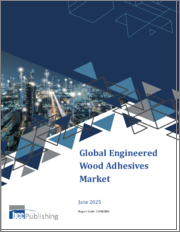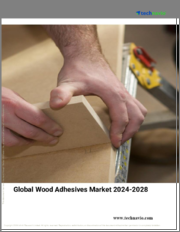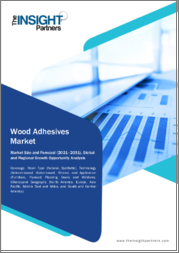
|
시장보고서
상품코드
1804696
목재 접착제 및 바인더 시장 : 수지 유형, 제품 유형, 형태, 최종 용도, 유통 채널별 - 세계 예측(2025-2030년)Wood Adhesives & Binder Market by Resin Type, Product Type, Form, End Use, Distribution Channel - Global Forecast 2025-2030 |
||||||
목재 접착제 및 바인더 시장은 2024년에는 44억 5,000만 달러로 평가되었으며, 2025년에는 46억 6,000만 달러, CAGR 4.84%로 성장하여 2030년에는 59억 1,000만 달러에 달할 것으로 예측됩니다.
| 주요 시장 통계 | |
|---|---|
| 기준 연도 2024년 | 44억 5,000만 달러 |
| 추정 연도 2025년 | 46억 6,000만 달러 |
| 예측 연도 2030년 | 59억 1,000만 달러 |
| CAGR(%) | 4.84% |
산업 전반에 걸쳐 지속가능한 건설 및 제조 관행을 형성하는 데 있어 첨단 목재 접착제의 중요한 역할에 대해 알아봅니다.
목재 접착제와 바인더는 현대 건설, 제조 및 포장 산업의 보이지 않는 중추 역할을 하고 있습니다. 그 성능과 신뢰성은 인공 목재 제품의 구조적 무결성, 가구 조립품의 내구성, 포장 솔루션의 지속가능성에 직접적인 영향을 미칩니다. 환경 규제가 강화되고 고성능, 저배출 재료에 대한 수요가 증가함에 따라 첨단 수지 화학제품, 친환경 배합, 혁신적인 응용기술의 개발이 가장 중요한 과제로 떠오르고 있습니다.
새로운 기술 혁신과 소비자 요구의 변화가 목재 접착제 및 바인더의 상황에 어떤 혁명을 가져오고 있는가?
기술의 비약적인 발전과 소비자 기대의 진화는 목재 접착제의 상황을 변화시켰습니다. 최근 수지 개발 동향은 페놀포름알데히드의 내구성과 폴리우레탄의 유연성 및 빠른 경화 특성을 통합한 하이브리드 접착제 플랫폼의 가능성을 이끌어내고 있습니다. 또한, 마이크로파 및 UV 경화 시스템의 등장은 도포 속도와 에너지 소비 프로파일을 재정의하여 생산 주기를 단축하고 운영 비용을 절감할 수 있게 해줍니다.
2025년 미국 관세의 공급망, 가격 역학, 세계 목재 접착제 교역 흐름에 대한 누적 영향 평가
미국의 2025년 추가 관세 조치의 도입은 세계 목재 접착제 공급망과 가격 구조에 큰 영향을 미치고 있습니다. 주요 수지 전구체에 대한 수입 관세는 해외 원료에 의존하는 제조업체의 원재료 비용을 상승시키는 반면, 국내 제조업체는 마진이 새로운 관세 환경에 적응함에 따라 경쟁 압력이 증가하고 있습니다.
목재 접착제의 다양한 수지 유형, 제품 형태, 최종 용도, 유통 채널을 탐색하는 중요한 세분화 인사이트를 공개합니다.
시장 세분화를 분석하면 수지 기술, 제품 배합, 물리적 형태, 용도 분야, 유통 전략에 걸쳐 다양한 고객 니즈에 대응할 수 있는 중요한 경로를 찾을 수 있습니다. 수지 분야에서는 에폭시계 접착제가 뛰어난 접착 강도와 내화학성을 발휘하는 반면, 멜라민 포름알데히드 수지는 내수성과 장식판용으로 각광받고 있습니다. 페놀포름알데히드계는 외장용 패널과 구조용 패널에 필수적이며, 폴리우레탄계는 유연성과 빠른 경화의 이점을 제공합니다. 요소 포름알데히드는 높은 비용 효율성으로 인해 인테리어 용도를 계속 지배하고 있습니다.
아메리카, 유럽, 중동 및 아프리카, 아시아태평양의 목재 접착제 시장 역학 및 성장 패턴 확인
목재 접착제 및 바인더 분야의 지역별 역학은 경제 성장 궤도, 규제 환경, 최종 이용 산업의 성숙도에 따라 뚜렷한 특징을 보이고 있습니다. 아메리카에서는 주거용 및 비주거용 주택의 견고한 건설 사이클과 리노베이션의 물결이 인테리어 및 구조용 접착제 시스템의 안정적인 소비를 촉진하고 있습니다. 한편, 현지 제조업체들은 리드타임을 단축하고 변화하는 관세정책에 대응하기 위해 니어쇼어링 전략을 활용하고 있으며, 탄력적인 생산기지로서 북미의 매력을 높이고 있습니다.
시장 리더십을 주도하는 주요 목재 접착제 제조업체의 주요 전략적 이니셔티브와 경쟁 차별화 요소 하이라이트
목재 접착제 및 바인더 분야의 주요 기업들은 시장에서의 포지셔닝을 강화하고 새로운 성장 동력을 촉진하기 위해 다양한 전략적 이니셔티브를 전개하고 있습니다. 일부 다국적 화학기업들은 석유화학 원료에 대한 의존도를 낮추는 지속가능한 바이오 기반 폴리머 플랫폼 개발을 가속화하기 위해 연구개발비를 강화하고 있습니다. 이러한 에코 이노베이션에 대한 노력은 학계 및 기술 인큐베이터와의 합작투자를 통해 자주 전해지고 있습니다.
목재 접착제의 새로운 기회를 활용하고 사업 효율성을 높이기 위해 업계 리더를 위한 실행 가능한 전략 제안
업계 리더는 기술 동향과 규제 동향을 적극적으로 활용하는 한편, 경영의 강인성을 확보해야 합니다. 첫째, R&D, 지속가능성, 애플리케이션 엔지니어링 등 각 부문의 기능을 통합한 범부서적 혁신 팀을 구성하여 친환경 수지 화학제품의 확장 가능한 접착제 배합으로 전환을 가속화할 수 있습니다. 이러한 협력적 접근 방식을 통해 개발 주기를 단축하고 진화하는 배출 기준에 원활하게 대응할 수 있습니다.
목재 접착제 시장 조사를 지원하는 데이터 소스, 분석 프레임워크, 검증 프로세스를 상세히 설명하는 종합적인 연구 방법론
본 조사에서는 종합적인 조사 대상과 분석 방법의 엄밀성을 확보하기 위해 다층적인 조사 방법을 채택하였습니다. 먼저, 공개 문헌, 특허 출원, 규제 가이드라인을 철저히 검토하여 수지의 화학적 특성, 배출 기준, 응용 기술에 대한 기초적인 이해를 심화시켰습니다. 이 탁상조사 단계에서는 기술백서, 산업협회 보고서, 포름알데히드 기준치 및 지속가능성 인증과 관련된 정부 지침에 대한 조사가 이루어졌습니다.
결론 진화하는 목재 접착제 부문의 이해관계자를 위한 주요 조사 결과, 전략적 시사점 및 향후 전망 요약
이 요약은 수지의 기술 혁신과 디지털화에서 관세 재편과 지역적 뉘앙스에 이르기까지 목재 접착제와 바인더의 상황을 형성하는 다면적인 힘을 밝혔습니다. 세분화에 대한 인사이트 통합은 제품 포트폴리오를 수지 유형, 공급 형태, 최종 용도 요건에 맞게 조정하는 것이 중요하다는 것을 강조합니다. 동시에 무역 정책의 검토는 민첩한 조달과 전략적 역량 투자의 필요성을 강조하고 있습니다.
목차
제1장 서문
제2장 조사 방법
제3장 주요 요약
제4장 시장 개요
제5장 시장 역학
제6장 시장 인사이트
- Porter's Five Forces 분석
- PESTEL 분석
제7장 미국 관세의 누적 영향 2025
제8장 목재 접착제 및 바인더 시장 : 수지 유형별
- 에폭시
- 멜라민 포름알데히드
- 페놀 포름알데히드
- 폴리우레탄
- 요소 포름알데히드
제9장 목재 접착제 및 바인더 시장 : 제품 유형별
- 1액형
- 2액형
제10장 목재 접착제 및 바인더 시장 : 형태별
- 액체
- 용제형
- 수성
- 고체
- 막
- 핫멜트
- 펠릿
제11장 목재 접착제 및 바인더 시장 : 최종 용도별
- 건설
- 비구조적
- 구조적
- 포장
- 골판지
- 솔리드 보드
- 특수 판지
- 목공
제12장 목재 접착제 및 바인더 시장 : 유통 채널별
- 오프라인
- 온라인
제13장 아메리카의 목재 접착제 및 바인더 시장
- 미국
- 캐나다
- 멕시코
- 브라질
- 아르헨티나
제14장 유럽, 중동 및 아프리카의 목재 접착제 및 바인더 시장
- 영국
- 독일
- 프랑스
- 러시아
- 이탈리아
- 스페인
- 아랍에미리트
- 사우디아라비아
- 남아프리카공화국
- 덴마크
- 네덜란드
- 카타르
- 핀란드
- 스웨덴
- 나이지리아
- 이집트
- 튀르키예
- 이스라엘
- 노르웨이
- 폴란드
- 스위스
제15장 아시아태평양의 목재 접착제 및 바인더 시장
- 중국
- 인도
- 일본
- 호주
- 한국
- 인도네시아
- 태국
- 필리핀
- 말레이시아
- 싱가포르
- 베트남
- 대만
제16장 경쟁 구도
- 시장 점유율 분석, 2024
- FPNV 포지셔닝 매트릭스, 2024
- 경쟁 분석
- 3M Company
- Akzo Nobel N.V.
- Arkema S.A.
- Ashland Global Holdings Inc.
- BASF SE
- Benson Polymers Ltd.
- Bondloc UK Ltd.
- Casco Adhesives AB
- Collano AG
- Dow Inc.
- Dynea AS
- Eastman Chemical Company
- Franklin International
- H.B. Fuller Company
- Henkel AG & Co. KGaA
- Hexion Inc.
- Huntsman International LLC
- Jowat SE
- Master Bond Inc.
- NANPAO Resins Chemical Group
- Parson Adhesives Inc.
- Permabond Engineering Adhesives Ltd.
- Sika AG
- Soudal Group
- Wacker Chemie AG
제17장 리서치 AI
제18장 리서치 통계
제19장 리서치 컨택트
제20장 리서치 기사
제21장 부록
KSM 25.09.11The Wood Adhesives & Binder Market was valued at USD 4.45 billion in 2024 and is projected to grow to USD 4.66 billion in 2025, with a CAGR of 4.84%, reaching USD 5.91 billion by 2030.
| KEY MARKET STATISTICS | |
|---|---|
| Base Year [2024] | USD 4.45 billion |
| Estimated Year [2025] | USD 4.66 billion |
| Forecast Year [2030] | USD 5.91 billion |
| CAGR (%) | 4.84% |
Exploring the Critical Role of Advanced Wood Adhesives in Shaping Sustainable Construction and Manufacturing Practices Across Industries
Wood adhesives and binders serve as the invisible backbone of modern construction, manufacturing, and packaging industries. Their performance and reliability directly influence the structural integrity of engineered wood products, the durability of furniture assemblies, and the sustainability credentials of packaging solutions. As environmental regulations tighten and demand for high-performance, low-emission materials intensifies, the development of advanced resin chemistries, eco-friendly formulations, and innovative application technologies has become paramount.
In recent years, the convergence of sustainability mandates and shifting consumer preferences has accelerated research into water-based and bio-based adhesive systems. This shift transcends traditional resin chemistries such as phenolic and urea formaldehyde, giving rise to next-generation polyurethane, melamine formaldehyde, and epoxy variants that offer enhanced bonding strength, reduced volatile organic compound emissions, and improved moisture resistance. As a result, decision-makers are under pressure to balance cost efficiency with regulatory compliance and long-term durability.
Consequently, a deep understanding of regional market dynamics, tariff landscapes, end-use demand drivers, and technological innovations is essential for stakeholders to navigate this evolving ecosystem. This executive summary introduces the key themes shaping the wood adhesives and binder sector, setting the stage for strategic insights that will empower manufacturers, distributors, and end users to make informed choices and capitalize on emerging opportunities.
How Emerging Technological Innovations and Shifting Consumer Demands Are Revolutionizing the Wood Adhesives and Binder Landscape
Technological breakthroughs and evolving consumer expectations have catalyzed transformative shifts in the wood adhesives landscape. Recent advances in resin development have unlocked the potential for hybrid adhesive platforms that integrate the durability of phenol formaldehyde with the flexibility and rapid curing characteristics of polyurethane. Moreover, the rise of microwave and UV-curing systems is redefining application speeds and energy consumption profiles, enabling faster production cycles and lower operational costs.
At the same time, regulatory pressures on formaldehyde emissions have prompted a reconsideration of legacy resin platforms. This dynamic has incentivized the adoption of low-emission melamine formaldehyde and bio-based resins derived from lignin, soy protein, and other renewable feedstocks. Furthermore, digitalization in process monitoring, such as real-time viscosity control and precision dosing, is enhancing quality assurance while minimizing waste.
Consequently, the industry is witnessing a paradigm shift toward lean manufacturing and closed-loop processing. As a result, manufacturers are forging strategic partnerships with chemical suppliers and equipment providers to co-develop tailor-made adhesive solutions that address stringent performance and sustainability criteria. In this context, understanding the interplay between material innovation, regulatory frameworks, and operational excellence is critical for driving competitive advantage.
Assessing the Cumulative Impact of United States Tariffs in 2025 on Supply Chains, Pricing Dynamics, and Global Wood Adhesive Trade Flows
The introduction of additional tariff measures by the United States in 2025 has exerted a pronounced influence on the global wood adhesives supply chain and pricing structures. Import levies on key resin precursors have elevated raw material costs for manufacturers reliant on overseas feedstocks, while domestic producers have faced increased competitive pressure as margins adjust to the new duty environment.
Consequently, procurement teams have intensified efforts to diversify supply sources, seeking alternative resin imports from regions with favorable trade agreements. This realignment has spurred closer collaboration between North American producers and resin suppliers in Asia-Pacific and the Middle East, leveraging preferential trade terms to stabilize input costs. In parallel, some end users are negotiating integrated supply contracts that lock in multi-year pricing and secure volume commitments, mitigating exposure to ad hoc tariff fluctuations.
Furthermore, the tariff landscape has prompted a reevaluation of onshore versus offshore production economics. Several adhesive manufacturers have accelerated investments in local polymerization capacity to reduce dependency on imports and enhance supply resilience. As a result, logistic networks are being recalibrated to optimize inventory buffers and minimize transit times.
Ultimately, the cumulative impact of the 2025 tariff measures underscores the importance of agile sourcing strategies, integrated cost management, and collaborative partnerships to sustain competitive positioning in a continually evolving global trade context.
Unveiling Critical Segmentation Insights to Navigate Diverse Resin Types, Product Forms, End Uses, and Distribution Channels in Wood Adhesives
Analyzing market segmentation reveals critical pathways for addressing diverse customer needs across resin technologies, product formulations, physical forms, application sectors, and distribution strategies. Within the resin spectrum, Epoxy adhesives deliver exceptional bond strength and chemical resistance, while Melamine Formaldehyde resins are prized for their water resilience and decorative laminates. Phenol Formaldehyde systems remain integral to exterior-grade and structural panels, whereas Polyurethane chemistries offer flexibility and rapid curing benefits. Urea Formaldehyde continues to dominate interior applications due to its cost effectiveness.
From a product composition standpoint, single-component systems facilitate ease of use and minimal on-site preparation, whereas two-component formulations unlock higher performance parameters and customizable cure profiles. Regarding physical form, liquid adhesives are available in solvent-based formats that ensure deep substrate penetration or water-based variants that minimize VOC emissions, while solid adhesives encompass precision-cut films for decorative overlays, hot melt blocks for thermal activation, and pellet forms suited to automated feed lines.
Examining end-use demand patterns, the construction segment spans non-structural architectural millwork through to load-bearing structural engineered products. Packaging applications leverage corrugated films for shipping containers, solid board laminations for retail packaging, and specialty paperboard for high-end consumer goods. The woodworking arena encompasses furniture, cabinetry, and architectural joinery where bond reliability and finish integrity are paramount. Distribution channels integrate traditional brick-and-mortar wholesalers with digital platforms, enabling streamlined procurement for both established workshops and emerging online retailers.
Examining Regional Market Dynamics and Growth Patterns Across the Americas, Europe Middle East & Africa, and Asia-Pacific Zones for Wood Adhesives
Regional dynamics in the wood adhesives and binder domain exhibit distinct characteristics shaped by economic growth trajectories, regulatory environments, and end-use industry maturity. In the Americas, a robust construction cycle and renovation wave in both residential and non-residential sectors drive steady consumption of interior-grade and structural adhesive systems. Meanwhile, local manufacturers are leveraging near-shoring strategies to minimize lead times and adjust to evolving tariff policies, reinforcing North America's appeal as a resilient production hub.
Across Europe, the Middle East & Africa, stringent emissions regulations and an emphasis on energy efficiency have catalyzed demand for low-VOC, eco-certified formulations. This region also benefits from established chemical infrastructure and research clusters, fostering collaborative innovation between resin developers and adhesive formulators. In parallel, growth in construction and packaging applications in Gulf Cooperation Council countries is reshaping distribution networks and prompting tailored adhesive blends to accommodate high-temperature conditions.
In the Asia-Pacific territory, expansive manufacturing bases and export-oriented furniture sectors fuel appetite for efficient, cost-effective adhesive systems. Market players in China, Southeast Asia, and India are rapidly adopting water-based technologies in response to urban air-quality mandates. Simultaneously, partnerships between local enterprises and global specialty chemical providers are accelerating the transfer of advanced resin technologies, enabling competitive differentiation in high-volume markets.
Together, these regional nuances underscore the importance of customized strategies that align supply chain configurations, product portfolios, and regulatory compliance frameworks with localized demand drivers.
Highlighting Key Strategic Initiatives and Competitive Differentiators of Leading Wood Adhesive Manufacturers Driving Market Leadership
Leading players in the wood adhesives and binder arena are deploying a spectrum of strategic initiatives to fortify market positioning and catalyze new growth vectors. Several multinational chemical companies have enhanced their R&D spending to accelerate the development of sustainable, bio-based polymer platforms that reduce reliance on petrochemical feedstocks. This commitment to eco-innovation is frequently communicated through joint ventures with academic institutions and technology incubators.
In parallel, select manufacturers have embarked on capacity expansion projects, constructing new polymerization units and retrofit lines to accommodate low-emission and high-performance formulations. These investments are often complemented by digitalization efforts, such as the integration of advanced analytics for predictive maintenance and process optimization. Consequently, production efficiencies improve while downtime and waste are curtailed.
Moreover, strategic collaborations between upstream resin suppliers and downstream adhesive formulators are becoming increasingly common. These alliances facilitate co-development initiatives that align molecular design with end-use application requirements, enabling rapid prototyping and accelerated time-to-market for novel adhesive solutions. Concurrently, partnerships with leading end users in construction, packaging, and woodworking sectors ensure real-world validation and early adoption of breakthrough technologies.
Actionable Strategic Recommendations for Industry Leaders to Capitalize on Emerging Opportunities and Enhance Operational Efficiency in Wood Adhesives
Industry leaders must adopt a proactive posture to capitalize on technological and regulatory trends while safeguarding operational resilience. First, forging cross-functional innovation teams that bring together R&D, sustainability, and application engineering functions will accelerate the translation of eco-friendly resin chemistries into scalable adhesive formulations. This collaborative approach can reduce development cycles and ensure seamless alignment with evolving emissions standards.
Next, diversifying supply chain footprints by balancing onshore production capacity with strategic import partnerships will mitigate tariff risks and raw material volatility. By establishing contingency agreements with multiple resin suppliers across different geographies, companies can maintain continuity of supply and negotiate volume-based incentives that stabilize input costs.
Furthermore, investing in digital process controls and Industry 4.0 frameworks will enable predictive maintenance, quality assurance, and real-time monitoring of adhesive curing parameters. This operational transparency not only reduces scrap rates but also facilitates data-driven decision making for product customization and value-added services.
Finally, cultivating end-user partnerships through joint innovation programs and collaborative pilot projects will sharpen product-market fit and unlock co-marketing opportunities. By demonstrating efficacy in targeted applications-from structural engineered wood to premium packaging laminates-manufacturers can differentiate their adhesive portfolios and foster long-term customer loyalty.
Comprehensive Research Methodology Detailing Data Sources, Analytical Frameworks, and Validation Processes Underpinning the Wood Adhesives Market Study
This study employs a multi-tiered research methodology designed to ensure comprehensive coverage and analytical rigor. Initially, a thorough review of public domain literature, patent filings, and regulatory guidelines established a foundational understanding of resin chemistries, emission standards, and application technologies. This desk research phase included examination of technical white papers, industry association reports, and governmental directives related to formaldehyde thresholds and sustainability certifications.
Subsequently, primary interviews were conducted with key stakeholders, including R&D directors, production managers, procurement leads, and end-user product developers. These qualitative insights provided contextual depth on formulation challenges, performance benchmarks, and supply chain constraints. Interview data were triangulated with quantitative input from internal production and shipment databases to validate adoption trends for emerging adhesive platforms.
Analytical frameworks such as PESTEL and Porter's Five Forces were applied to assess macroeconomic drivers, regulatory influences, and competitive dynamics. Scenario analysis explored alternative tariff and raw material cost trajectories, while technology readiness evaluations quantified the maturity and scalability of innovative resin systems. Throughout the process, findings were subjected to iterative expert reviews to ensure accuracy and relevance.
Conclusion Summarizing Core Findings, Strategic Implications, and Future Outlook for Stakeholders in the Evolving Wood Adhesives Sector
This executive summary has illuminated the multifaceted forces shaping the wood adhesives and binder landscape, from resin innovation and digitalization to tariff realignments and regional nuances. The synthesis of segmentation insights underscores the importance of aligning product portfolios with resin types, delivery forms, and end-use requirements. At the same time, the examination of trade policies highlights the imperative for agile sourcing and strategic capacity investments.
Collectively, these insights emphasize that sustainable growth in this sector hinges on harmonizing performance demands with environmental compliance and operational excellence. Advanced resin platforms, integrated supply chain strategies, and digital process controls will remain the cornerstones of competitive differentiation. Moreover, regional market variations will demand tailored approaches that respect local regulatory frameworks and consumption patterns.
As the sector continues to evolve, stakeholders who embrace collaborative innovation, diversify supply networks, and maintain a forward-looking perspective on sustainability will be best positioned to navigate emerging challenges and capitalize on new market opportunities. The integrated findings of this report serve as a strategic compass for executives, guiding informed decision making in an increasingly complex and dynamic environment.
Table of Contents
1. Preface
- 1.1. Objectives of the Study
- 1.2. Market Segmentation & Coverage
- 1.3. Years Considered for the Study
- 1.4. Currency & Pricing
- 1.5. Language
- 1.6. Stakeholders
2. Research Methodology
- 2.1. Define: Research Objective
- 2.2. Determine: Research Design
- 2.3. Prepare: Research Instrument
- 2.4. Collect: Data Source
- 2.5. Analyze: Data Interpretation
- 2.6. Formulate: Data Verification
- 2.7. Publish: Research Report
- 2.8. Repeat: Report Update
3. Executive Summary
4. Market Overview
- 4.1. Introduction
- 4.2. Market Sizing & Forecasting
5. Market Dynamics
- 5.1. Adoption of low-emission adhesives in furniture manufacturing to comply with stricter indoor air quality regulations
- 5.2. Integration of nanotechnology in wood adhesive formulations for enhanced bond strength and durability
- 5.3. Shift toward waterborne polyurethane adhesives to reduce VOC emissions and environmental footprint
- 5.4. Development of formaldehyde-free resins to meet evolving health and safety standards in architectural wood products
- 5.5. Collaboration between adhesive producers and panel manufacturers to tailor binders for engineered wood demand
- 5.6. Use of lignin-derived adhesive components as a renewable alternative to petroleum-based resins in plywood applications
- 5.7. Investment in digital dispensing systems to optimize adhesive application and reduce manufacturing waste
- 5.8. Growth in demand for fast-curing adhesives to accelerate production cycles in modular and prefabricated wood construction
- 5.9. Implementation of life cycle assessment tools to evaluate environmental impact of adhesive products across supply chains
- 5.10. Rising consumer preference for low-odor adhesives boosting research in odor-neutralizing binder technologies
6. Market Insights
- 6.1. Porter's Five Forces Analysis
- 6.2. PESTLE Analysis
7. Cumulative Impact of United States Tariffs 2025
8. Wood Adhesives & Binder Market, by Resin Type
- 8.1. Introduction
- 8.2. Epoxy
- 8.3. Melamine Formaldehyde
- 8.4. Phenol Formaldehyde
- 8.5. Polyurethane
- 8.6. Urea Formaldehyde
9. Wood Adhesives & Binder Market, by Product Type
- 9.1. Introduction
- 9.2. One Component
- 9.3. Two Component
10. Wood Adhesives & Binder Market, by Form
- 10.1. Introduction
- 10.2. Liquid
- 10.2.1. Solvent Based
- 10.2.2. Water Based
- 10.3. Solid
- 10.3.1. Film
- 10.3.2. Hot Melt
- 10.3.3. Pellet
11. Wood Adhesives & Binder Market, by End Use
- 11.1. Introduction
- 11.2. Construction
- 11.2.1. Non Structural
- 11.2.2. Structural
- 11.3. Packaging
- 11.3.1. Corrugated
- 11.3.2. Solid Board
- 11.3.3. Specialty Paperboard
- 11.4. Woodworking
12. Wood Adhesives & Binder Market, by Distribution Channel
- 12.1. Introduction
- 12.2. Offline
- 12.3. Online
13. Americas Wood Adhesives & Binder Market
- 13.1. Introduction
- 13.2. United States
- 13.3. Canada
- 13.4. Mexico
- 13.5. Brazil
- 13.6. Argentina
14. Europe, Middle East & Africa Wood Adhesives & Binder Market
- 14.1. Introduction
- 14.2. United Kingdom
- 14.3. Germany
- 14.4. France
- 14.5. Russia
- 14.6. Italy
- 14.7. Spain
- 14.8. United Arab Emirates
- 14.9. Saudi Arabia
- 14.10. South Africa
- 14.11. Denmark
- 14.12. Netherlands
- 14.13. Qatar
- 14.14. Finland
- 14.15. Sweden
- 14.16. Nigeria
- 14.17. Egypt
- 14.18. Turkey
- 14.19. Israel
- 14.20. Norway
- 14.21. Poland
- 14.22. Switzerland
15. Asia-Pacific Wood Adhesives & Binder Market
- 15.1. Introduction
- 15.2. China
- 15.3. India
- 15.4. Japan
- 15.5. Australia
- 15.6. South Korea
- 15.7. Indonesia
- 15.8. Thailand
- 15.9. Philippines
- 15.10. Malaysia
- 15.11. Singapore
- 15.12. Vietnam
- 15.13. Taiwan
16. Competitive Landscape
- 16.1. Market Share Analysis, 2024
- 16.2. FPNV Positioning Matrix, 2024
- 16.3. Competitive Analysis
- 16.3.1. 3M Company
- 16.3.2. Akzo Nobel N.V.
- 16.3.3. Arkema S.A.
- 16.3.4. Ashland Global Holdings Inc.
- 16.3.5. BASF SE
- 16.3.6. Benson Polymers Ltd.
- 16.3.7. Bondloc UK Ltd.
- 16.3.8. Casco Adhesives AB
- 16.3.9. Collano AG
- 16.3.10. Dow Inc.
- 16.3.11. Dynea AS
- 16.3.12. Eastman Chemical Company
- 16.3.13. Franklin International
- 16.3.14. H.B. Fuller Company
- 16.3.15. Henkel AG & Co. KGaA
- 16.3.16. Hexion Inc.
- 16.3.17. Huntsman International LLC
- 16.3.18. Jowat SE
- 16.3.19. Master Bond Inc.
- 16.3.20. NANPAO Resins Chemical Group
- 16.3.21. Parson Adhesives Inc.
- 16.3.22. Permabond Engineering Adhesives Ltd.
- 16.3.23. Sika AG
- 16.3.24. Soudal Group
- 16.3.25. Wacker Chemie AG



















